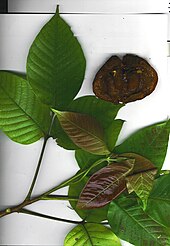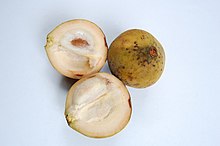Santol (plant)
| Santol | ||||||||||||
|---|---|---|---|---|---|---|---|---|---|---|---|---|

Santol tree ( Sandoricum koetjape ) |
||||||||||||
| Systematics | ||||||||||||
|
||||||||||||
| Scientific name | ||||||||||||
| Sandoricum koetjape | ||||||||||||
| ( Burm.f. ) Merr. |
Sandoricum koetjape is a plant from the genus of Sandoricum in the family of meliaceae (Meliaceae). The fruit is called Santol and is widely grown in Southeast Asia and many other tropical areas.
description
Appearance and foliage leaf
Sandoricum koetjape is a fast-growing, mostly evergreen (in dry regions also deciduous), large tree with a height of 20 to 45 meters. The straight trunk has a brownish, relatively smooth bark , which sometimes flakes off in rounded flakes. Old specimens have buttress roots or are fluted at the base of the trunk. The tree has a milky sap .
The alternate and spirally arranged leaves on the branches are long-stalked. The threefold leaf blade is composed of three leaf sections. The entire, soft and more or less pedicled leaflets are elliptical to oblong-ovate with a length of 20 and 25 cm with a pointed to blunt or heart-shaped base and a pointed to rounded upper end. The veins of the leaflets are pinnate and impressed on the upper side.
Inflorescence and flower
The 20 to 30 cm long, fine-haired paniculate inflorescences are located on young branches above axillary inflorescence shafts . The greenish, yellowish or pinkish-yellow and hermaphrodite, short-stalked flowers are about 1 cm in size. The small, slightly five-lobed and cup-shaped calyx is somewhat hairy. There are five, laid back, fleshy, weak-haired and green, elongated and rounded petals . The stamens are fused into a conical, yellowish, ribbed tube with toothed top and the 8–10 anthers are located on top of the teeth, on the inside of the tube. The small, multi-chambered ovary is on top with a club-shaped stylus , with a large and lobed scar head that ends approximately at the level of the anthers. The ovary is surrounded by a short, free and toothed disc tube . The flowers have a small fore and two bracts .
Fruit and seeds
The round, slightly flattened, slightly leathery berries (armored berries ) (or a stone fruit ) with a diameter of 4 to 7.5 cm often have wrinkles and ribs. When ripe, the fruits, which are yellowish to gold or orange, sometimes reddish to brownish, have a thin to thick skin with a soft, hairy surface and contain a milky juice. There are three to five seeds in the fruit . The seeds lie in an edible, soft, somewhat fibrous and white, attached fruit pulp (inner mesocarp ). The white, transparent, juicy fruit pulp has a sweet but very sour aroma, but the outer mesocarp is also edible. The brown, elliptical to egg-shaped, up to 1.6–2 cm long, somewhat flattened seeds are indigestible and therefore not suitable for consumption. The seed coat is divided into Testa and Tegmen or into a sarco, sclero and endotesta. The fruits ripen on the Malay Peninsula in June and July, in Florida in August and September, in the Philippines from July to October.
distribution
Sandoricum koetjape is probably native to Indochina , especially Cambodia and southern Laos , as well as the Malay Peninsula . It was introduced to many areas a long time ago and is now widespread from India to the Andamans, Moluccas and Mauritius to the Philippines, Malaysia and Indonesia. Santol is widely grown as a fruit in Southeast Asia and many other tropical areas.
Taxonomy
The first publication of this species was in 1768 under the name ( Basionym ) Melia koetjape by Nicolaas Laurens Burman in Flora Indica ... nec non Prodromus Florae Capensis , p. 101. It was published in 1912 under the name Sandoricum koetjape by Elmer Drew Merrill in the Philippine Journal of Science , Volume 7 (4), p. 237 placed in the genus Sandoricum . Other synonyms for Sandoricum koetjape (Burm. F.) Merr. are: Sandoricum indicum Cav. , Sandoricum nervosum flower .
use
The fruits are usually eaten raw as fruit, they have to be peeled. In India they are eaten with spices. They are used in jams, jellies, syrups or chutney, among other things. Overripe fruits are used with rice to make an alcoholic drink.
For medicinal purposes, crushed leaves are used to relieve itching of the skin. In folk medicine in the Philippines, fresh leaves are placed on the heated body when there is a fever to make it more sweaty.
The initially gray, after drying reddish-brown wood is relatively hard and easy to work with, so that it can be used in many ways. However, it is often of poor quality, is prone to insect infestation and faster weathering in damp environments.
swell
- J. Morton: Santol - Sandoricum koetjape Merr. , Pp. 199-201, In: Julia F. Morton: Fruits of warm climates , 1987, Miami, FL. Santol - Online at Purdue University's Crop Index .
Individual evidence
- ^ A b Sandoricum koetjape in the Germplasm Resources Information Network (GRIN), USDA , ARS , National Genetic Resources Program. National Germplasm Resources Laboratory, Beltsville, Maryland.
- ↑ a b c d e f g h i J. Morton: Santol - Sandoricum koetjape Merr. , Pp. 199-201, In: Julia F. Morton: Fruits of warm climates , 1987, Miami, FL. Santol - Online at Purdue University's Crop Index .
- ^ Merrill scanned in 1912 at biodiversitylibrary.org .
- ↑ Sandoricum koetjape at Tropicos.org. Missouri Botanical Garden, St. Louis



